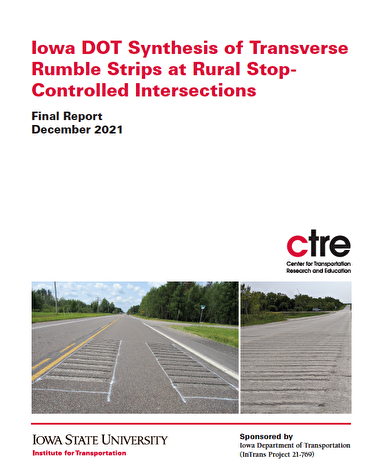
In response to a fatal crash several years ago, Iowa is making a concerted effort to determine the best way to implement transverse rumble strips (TRS).
“Drivers failing to recognize and stop at rural stop-controlled intersections are a significant safety issue that resulted in an estimated two to three percent of all fatal crashes within Iowa for the five years from 2016 through 2020,” says Nicole Oneyear, research scientist with Iowa State University and principal investigator for a research project tasked with studying TRS. The project was sponsored by the Iowa DOT.
TRS are made by either creating grooves in pavement or by installing raised strips of plastic, rubber, or thermoplastic. They provide audio and tactile warnings for drivers even in poor visibility.
The study was ordered as part of a 2020 House Study Bill from the Iowa State Legislature, nicknamed “Baylee’s Bill” after a particular fatal car crash where the driver failed to stop at an intersection because of low visibility—something TRS could have potentially prevented.
The literature review for the project found that installing TRS can reduce crashes by 20 to 40 percent at stop-controlled intersections. A 2006 study in Minnesota found that TRS can also reduce the approaching speeds of vehicles by 2 to 5 mph.
Some drawbacks need to be considered, however. Motorcyclists and bicyclists, Oneyear says, cannot comfortably drive over rumble strips, which may also pose safety issues. Smooth paths need to be left either down the middle of the rumble strips or on the shoulder to accommodate them.
Noise is also a major problem, she says. Many states set a minimum distance between TRS and residential areas (usually around 650 feet). There has been some consideration for rumble strips with shallower, quieter grooves, although an ideal groove depth has not been fully researched.
The original plan outlined in Baylee’s Bill proposed installing TRS systematically across the state, but a survey of other states’ practices found that targeted, “hot-spot” installation might also have promise. Most states use the targeted approach, Oneyear says, usually based on crash history for a given site.
Many states—including Minnesota—also recommend using other countermeasures (such as removing sight obstructions, adding flashing lights, and doubling up stop signs) before installing rumble strips.
Targeted installation was found to be more cost-effective (five to six times higher) than systematic installation. Guidelines from the National Cooperative Highway Research Program suggest that using TRS sparingly might be more effective overall, since rumble strips work better when they are out of the ordinary.
“A targeted approach that identifies sites for installation of TRS through a combination of both a traditional hot spot and systemic screening will likely lead to the largest safety benefits,” Oneyear says.
—Sophie Koch, contributing writer
Learn more:
- Iowa DOT Synthesis of Transverse Rumble Strips at Rural Stop-Controlled Intersections (Iowa DOT, Dec. 2021)